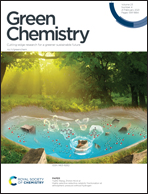Hybridization of MOFs and ionic POFs: a new strategy for the construction of bifunctional catalysts for CO2 cycloaddition†
Abstract
A new strategy toward constructing a bifunctional catalyst for CO2 cycloaddition has been developed based on post-synthetic modification of CUS-based metal–organic frameworks (MOFs) with ionic porous organic frameworks (POFs) to form MOF@iPOF core–shell hybrid materials. Based on this strategy, two new MOF@iPOF core–shell hybrid materials, Cu3(BTC)2@iPOF-TB-Br− and Cu3(BTC)2@iPOF-TM-Br−, are synthesized for the first time by feasible encapsulation of a Cu3(BTC)2 core within an ionic POF shell. Because of the synergetic role of dual functional sites including CUS as a Lewis acid in the MOFs and the Br− anion as the nucleophile in the ionic POFs, Cu3(BTC)2@iPOF-TB-Br− and Cu3(BTC)2@iPOF-TM-Br− demonstrate excellent catalytic performance for the CO2 cycloaddition under co-catalyst free mild conditions (60 °C, 0.5 MPa CO2, 24 h). Moreover, these core–shell bifunctional catalysts can not only realize the synergy of two functional sites, but also maintain the porosity of hybrid materials for improving the mass transfer rate and catalytic efficiency.



 Please wait while we load your content...
Please wait while we load your content...